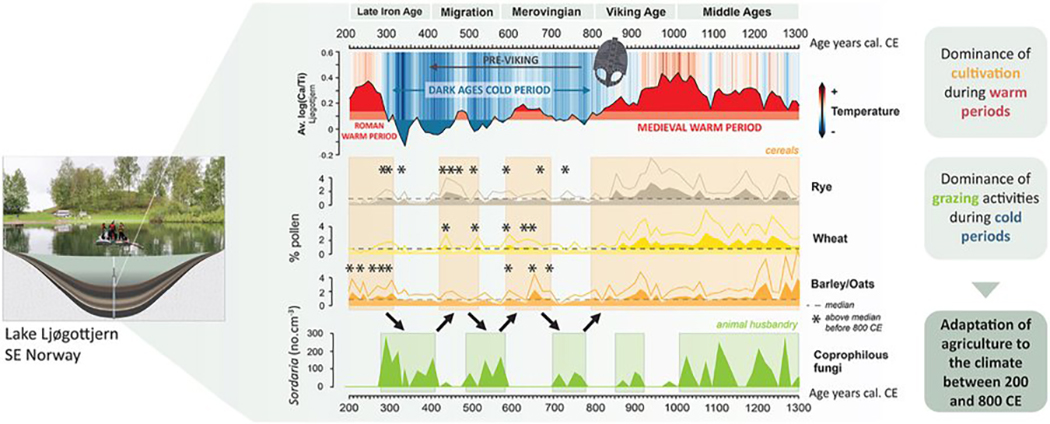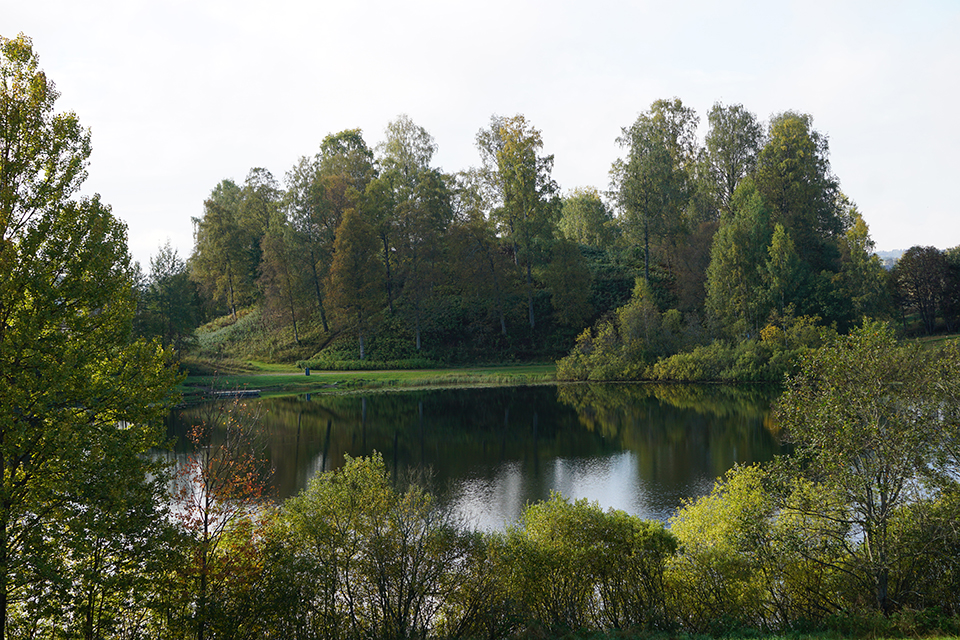Did climate changes in pre-Viking societies really matter? Did people adapt their agricultural strategies? Or were such climate changes just registered as temporarily “whacky weather” by the people of the past?
From AD 300, weather in Late Antiquity deteriorated. Stormy, colder and less predictive, it culminated in the decades following AD 536–574, when a number of huge volcanic eruptions took place forcing a significant downturn. Reportedly, the following century was marked by the abandonment of farms and likely widespread migrations. Likely, it also harboured a profound shift in religion and belief systems.
Turning to microhistory, we now know that pre-Viking societies in Scandinavia and around the Baltic also instigated profound shifts in the settlement patterns and more comprehensive societal organisation. In particular, during the period from ca. AD 300–800, when the weather became colder and harsher, larger farms were divided into smaller production units, or settlements simply disappeared. We also know that the cultivation of rye became more widespread, while husbandry and transhumance gained importance as part of the agricultural strategies. Several explanations for these profound changes – which may be linked – have been offered, such as climate deterioration, depopulation caused by the Justinian Plague, or new warfare techniques (the introduction of equestrian elites).
However, the precise understanding of these coupled explanations and their direct impact is elusive. Understanding how the Viking societies were impacted by past climate variability and how they adapted to it has hardly been investigated until now.
Recently, a group of Norwegian scientists and archaeologists have worked together “to carry out a new multi-proxy investigation of lake sediments, including geochemical and palynological analyses, to reconstruct past changes in temperature and agricultural practices of pre-Viking and Viking societies in Southeastern Norway during the period between AD 200 and 1300.” The periods, AD 200–300 and AD 800–1300, were warmer than the AD 300-800 period, known as the “Dark Ages Cold Period” (or LALIA), they conclude. More precisely, the periods between AD 280-410, 480-580 and again 700-780 were characterised by extensive grazing activities indicated by spores from fungi living on the feces from herbivores as well as nettles, sorrels and alder-trees, all indicative of a more open and grazed landscape. More precisely, the analysis of the sediments showed the shifts in pollen and ascospores.
Between AD 680-800, the record even seems to have included a widespread abandonment of the site. Interestingly, though, this abandonment does not tally with the coldest period indicating another explanation should be sought. The scientists suggest that the involvement of a smallpox virus might be partly responsible. Another Swedish study – not mentioned here – recently argued for the role of ergotism following upon the more widespread cultivation of rye.
This cold period was punctuated by temperate intervals, which were dominated by the cultivation of cereals and hemp (before AD 280, AD 420-480, AD 580-700, and after AD 800). In between, cold intervals were dominated by livestock farming. The research results indicate that the pre-Viking societies micromanaged their agricultural strategy in response to climate variability during the Late Antiquity.
The conclusion is based on a unique multi-proxy study of carbon-14-dated sediments from Lake Ljøgottjern in the historic Romerike region. Four farmsteads in the neighbourhood of the lake – Haug, Ljøgot, Østra Hovin and Nordre Hovin – have been dated to the first century, while the largest burial mound in Northern Europe, Raknehaugen, was built in the mid 6th century on the shore of the lake. The construction of the mound is likely also detectable in the profile of the sediments.

Wider perspective
In a parallel publication, the group has also published a more long-term study of the interplay between the cultural, ecological and climatic factors driving changes in flora and fauna. These shifts are essential when trying to grasp how our modern ecosystems were shaped. The part of the study from Lake Ljøtgottjern have shown that “vegetation changes were primarily related to natural processes during most of the Holocene – ca. 8000-300 BC up until the Early Iron Age, ca. 500 BC.” At this point, human population density increased. Accordingly, overall shifts in the exploitation pattern in the region during and after the Iron Age should be explained as a reflection of the undulating population density. However, behind this coupling lies the obvious climatic shifts and their derivative consequences related to surface temperatures. The authors write:
“This led to a rapid shift in plant communities, presence of livestock, increased erosion and high charcoal concentrations. Together, the integrated multiproxy results from our study show the complex relations between environmental changes, facilitate the understanding of the coupled dynamics of climate, soils, human activities, and vegetation during the Holocene, and specifically highlight the importance of anthropogenic activities in long-term shaping of plant communities”, to which we might add: this long-term shaping of plant communities directly reflected the shifts in pastoral activities versus grain cultivation.
SOURCES
Climate adaptation of pre-Viking societies
By Manon Bajard, Eirik Ballo, Helge I. Høgh, Jostein Bakke, Eivind Støren,
Kjetil , Frode Iversen, William Hagopian, Anne H. Jahren, Henrik H. Svensen, Kirstin Krüger,
In: Quarternary Science Reviews (2022), Vol 278, 107374 (Open Access)
Anthropogenic and environmental drivers of vegetation change in southeastern Norway during the Holocene
By A.T.M.ter Schure ,M.Bajard, K.Loftsgarden, H.I.Høeg, E.Ballo, J.Bakke, E.W.N.Støren, F.Iversen, A.Kool, A.K.Brysting, K.Krüger, and S.Boessenkool
In: Quaternary Science Rewievs 2021-09-04 (Open Access)
SEE MORE
Presentation of the results: Climate variability controlled the development of the pre-Viking society during the Late Antiquity in Southeastern Norway
By: Manon Bajard
